Knowledge Economy Unfolds via All Things Digital-Social—Wearing Passion and Personality on Your Sleeve
Discerning Web 2.0 from Web 1.0—Ron May Gets Comeuppance as Happy and Successful
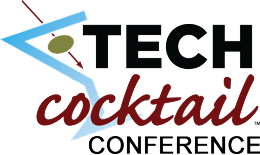 Web 2.0 entrepreneurs, financiers and professional services folk descended on Loyola University Chicago’s Lewis Hall 29 May 2008 for “Tech Conference,” TechCocktail’s first ever day-long educational event. Founders Frank Gruber and Eric Olson served an effervescent yet heady elixir of heart-to-heart war stories, lessons learned and strategies by entrepreneurs, venture capitalists, lawyers, accountants and an executive coach.
Web 2.0 entrepreneurs, financiers and professional services folk descended on Loyola University Chicago’s Lewis Hall 29 May 2008 for “Tech Conference,” TechCocktail’s first ever day-long educational event. Founders Frank Gruber and Eric Olson served an effervescent yet heady elixir of heart-to-heart war stories, lessons learned and strategies by entrepreneurs, venture capitalists, lawyers, accountants and an executive coach.
Since attending TechCocktail 1 in July 2006, I have promoted the periodic TechCocktail “meetups” to everyone who will listen as the place to learn about and connect with Web 2.0 players and technology in Chicago (elsewhere now, too). Frank and Eric have created one of the most worthwhile groups and communities in the city and were recognized in the ITA’s Citylights this year. Their first conference was both high value and quintessentially Web 2.0: speakers were open about what had worked and what hadn’t. The program was well balanced, organized and entertaining. There were considerable lessons for Web 2.0 entrepreneurs and their providers to take away.
From my notes, I have summarized the sessions and speakers’ main points before adding my between-the-lines Analysis and Conclusions. By the way, photos’ alt tags synch names with people in order.
| Speakers | Subject |
| Frank Gruber & Eric Olson, Founders TechCocktail | Welcome to TECH CONFERENCE |
| Mike Domek, Founder, TicketsNow | You Can Build a Business From Anywhere |
| Harper Reed & Scott VanDenPlas, Tech Guys, Skinnycorp | Looking at Technology For Your Business In New Ways |
| Sean Ammirati, moderator, Panel: Keith Schacht, Troy Henikoff, Nick O’Neill, Alex Bard | Leveraging Social Apps & Widgets For Your Business |
| Adrian Holovaty, Founder, Everyblock | Startups, The Chicago Way: Avoiding The Silicon Valley Echo Chamber |
| Nick Fera, Parlano/Microsoft | How to Think About Partnerships (no coverage) |
| Allan Cox, Author, Your Inner CEO | Discovering Your Inner CEO |
| Jason Fried, Founder 37signals | Getting Real Keynote (no coverage) |
| Moderator: Nate Westheimer; Panel: Evan Brown, Daliah Saper & Gary Barron | Starting Up: What’s the deal with legal and accounting? |
| Moderator: Sean Ammirati; Panel: Danielle Wiley, David Armano, Frank Gruber & Geoff Livingston | Creating A Brand Leveraging New/Social Media For Your Business |
| Moderator: Shawn Bolan; Panel: Jen Consalvo, Genevieve Thiers & Blagica Bottigliero | Understanding Your Audience (The Female Perspective) |
| Moderator: Eric Olson; Panel: Matthew McCall, Kirk Wolfe, Rob Schultz, Bruce Barron & Brad Feld | How to find funding (no coverage) |
| Dick Costolo, Founder, Feedburner (to Google) | Ask the Wizard LIVE |
| Gary Vaynerchuk, Founder, Wine Library TV | How to Grow a Community for a Traditional Business |
| Frank Gruber & Eric Olson, Founders TechCocktail | Closing Remarks: Onward to Barleycorn’s |
| Not covered: | |
| In “Breakout Room 208,” there was a fantastic day of talks and technical demos on which I have not reportage as I was in the main room all day and had to step out for a couple calls. | |
Welcome to Tech Conference, Frank Gruber and Eric Olson
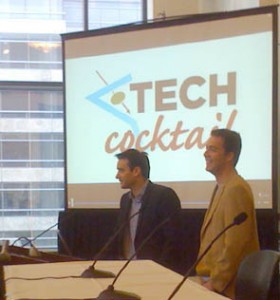 Short and sweet intro featuring Frank singing the Ballad of TechCocktail and accompanying himself on guitar.
Short and sweet intro featuring Frank singing the Ballad of TechCocktail and accompanying himself on guitar.
You Can Build a Business From Anywhere, Mike Domek
Mike gave the audience a from-the-heart, off-the-cuff story of the birth and growth of TicketsNow. He was an inspirational start to Tech Conference, as TicketsNow was the story of a guy who loved events and tickets who dropped out of school, who took chances and tapped, er, non-traditional team members (wallboard installers, coder-dudes who worked for Bulls tickets) to build the early team.
He had these five pearls of wisdom for tech entrepreneurs:
- Start with passion, not an exit strategy. There will be very hard times, and your love and passion can pull you through. If you’re in it for the money only, you will find the hard times unbearable and may quit before you should.
- Know your strengths and limits. This is key. You need to be a good judge of this so you can assemble people around you appropriately.
- Learn from mistakes… fast. Making mistakes is necessary when you are doing something that no one else has done, at least the way you are doing it. You’re taking risks, and learning from mistakes makes you smarter.
- Don’t be entitled. Do not think you deserve to succeed. Launching a venture is hard, and most people don’t succeed the first time.
- Let talent follow opportunity.
The story. Mike began TicketsNow with an 800 number. He got loyal customers by giving excellent service and working hard. He also learned the tickets ecosystem over time. He got a programmer to write a system, working for Bulls tickets. In 2000-01, the company bet big on key ad words that fell drastically in price during the market meltdown, and that worked because the company knew the business and how people thought (what words to buy).
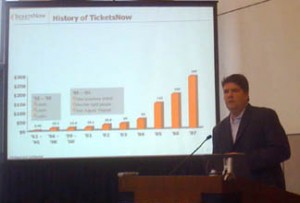 Another breakthrough was launching the affiliate program in which other people sold tickets on their websites for a commission. In 2004-05 the company had grown considerably, and they took the huge step of bringing in professional management. The website was crashing pretty regularly due to growth. They took local venture capital (Portage Ventures) in 2006, and professional management made much-needed process improvements, returning the company to profitability. They got acquired by Ticketmaster with lightning speed in 2007.
Another breakthrough was launching the affiliate program in which other people sold tickets on their websites for a commission. In 2004-05 the company had grown considerably, and they took the huge step of bringing in professional management. The website was crashing pretty regularly due to growth. They took local venture capital (Portage Ventures) in 2006, and professional management made much-needed process improvements, returning the company to profitability. They got acquired by Ticketmaster with lightning speed in 2007.
Here are Mike’s thoughts on taking venture capital and bringing in professional management:
- Entrepreneurs work hard toward profit, but profit isn’t expected. Professionals have planned profits.
- Professionals will insist on formal business plans, where entrepreneurs often don’t use them.
- Professionals create formal org charts which is good when your business is scaling.
- Ticketsnow took money because competitors were well funded, and they needed to compete. Also Mike wanted to spread the risk.
Looking at Technology For Your Business In New Ways, Harper Reed & Scott VanDenPlas
Harper and Scott definitely took the award for having the funniest session (Harper: “Inventory is serious shit, man.”), but there were plenty of serious lessons, too. Web 2.0 businesses like darling Threadless don’t escape the banal (completely, anyway ,^):
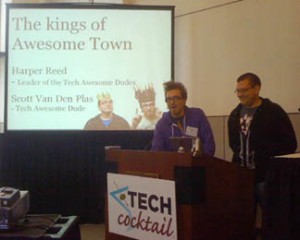 One of the thorniest problems Harper and Scott discussed was printing out packing slips in high volume for the online t-shirt producer whose online community votes on what designs the company will make into t-shirts that month. Threadless is a Web business using mostly open source, technology agnostic software, and their team learned that CSS was feckless for doing serious printing. The silver bullet turned out to be CUPS.
One of the thorniest problems Harper and Scott discussed was printing out packing slips in high volume for the online t-shirt producer whose online community votes on what designs the company will make into t-shirts that month. Threadless is a Web business using mostly open source, technology agnostic software, and their team learned that CSS was feckless for doing serious printing. The silver bullet turned out to be CUPS.- One of their challenges is keeping t-shirt design artists engaged. There is quite a bit of mobility, although there are plenty of new artists coming in to replace those who move on.
- Threadless produces high volume sales of discrete items in limited quantities. Its two main channels are the website and retail. They are struggling with producing a real-time picture of inventory that’s available by all channels. They need a point of sale system.
- Growing while maintaining culture. As a start-up, Threadless has a playful, innovative culture, but as it grows, management is feeling the need to formalize somewhat, so they can scale processes.
- Threadless customers tend to be technical and therefore put up with some of the website’s idiosyncrasies; the company’s community is legendary, and this extends to helping identify website errors and malfunctions, which the team quickly fixes.
- Threadless is kind of vanilla, as shirts go. The company is not “high-end” enough for some artists who would like to be discovered (reading between the lines, the company may need a review of its current and planned positioning and value proposition).
- Another issue is getting the value from the recent “second channel” (the store). They are exploring how to produce more synergy.
Leveraging Social Apps & Widgets For Your Business, Sean Ammirati, Keith Schacht, Troy Henikoff, Nick O’Neill, Alex Bard
Widgets are rapidly becoming key tools for creating Web 2.0 experience within social sites, and this session explained some key technical considerations of building social sites. Widgets are little self-contained islands of functionality that invoke information from other websites, usually with a fairly defined scope of action. There was considerable discussion about the viability of “widget building” as a business opportunity.
- Nick felt a key definition involved the distribution of content.
- Troy introduced a kind of “widget taxonomy.” There are four types: 1) Ads of the CPM model (Feedburner), 2) brand building (Ford), 3) drive intent to purchase (Visual Bookshelf on Facebook) and 4) connectors of disparate content; he could see a role for them bridging social sites so that profiles could seamlessly appear where the person is.
- Alex pointed out that they make functionality and data very portable; they enable social networks to borrow audiences, traffic.
- Keith remarked that widgets conformed to the power law in which a “short head” is followed by a “long tail.” In other words, few widgets are really popular.
- In the early days (of Facebook, for example), it was pretty easy to create a widget and to win large readership, but now it’s really difficult. There was some dissent about how easy or difficult it was. Widgets on Facebook can drive serious traffic to a blog or website. But the barrier to entry is quite low, which can serve to crowd out existing players.
- Based on the discussion, I think that the context of applying widgets to B2B would be different. B2B is more long tail territory, where Facebook is more about B2C/C2C sharing of essentially social content. In that context, fast-moving novelty is key. B2B is a different animal because it’s in the worksteam of the company, and information is very specific. Widget makers would have to know the business processes for which they were designing, and they’d have to deal with enterprise systems. This would probably be more feasible than it sounds when you recognize the strong adoption of SOA and Web services, which are loosening up enterprise data.
Startups, The Chicago Way: Avoiding The Silicon Valley Echo Chamber, Adrian Holovaty
Adrian Holovaty presented a fascinating website and fledgling company, EveryBlock, which invokes a combination of government and user-generated content for individual blocks in a city (currently Chicago, New York and San Francisco). He presented EveryBlock as an example of how innovation can triumph in Chicago. Highlights:
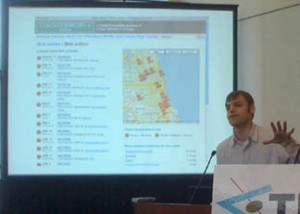 EveryBlock invokes (sometimes painfully ,^) city data from police, permitting, films and licensing as well as real estate, newspapers and consumers. It aims to be a completely new experience of “news” because it’s hyperlocal.
EveryBlock invokes (sometimes painfully ,^) city data from police, permitting, films and licensing as well as real estate, newspapers and consumers. It aims to be a completely new experience of “news” because it’s hyperlocal.- EveryBlock features these categories of “news” about your block: news, building permits, business licenses, business reviews, city press releases, crimes, filmings, liquor license applications, lost/found posts, photos, property transfers, real estate listings, restaurant inspections and street closures. I highly encourage you to visit the site and type in your address.
- The business is embryonic; the company won a grant from the Knight News Challenge, an annual contest held by the Knight Foundation.
- Here are some lessons learned:
- Take advantage of existing data; most of what EveryBlock uses is being produced in large amounts, but it’s not used efficiently.
- Appeal to civil servants; government should focus on services, so EveryBlock sees itself as a useful partner.
- Treat data with respect; it is valuable but many people don’t realize it.
- Government data is very difficult to access, and that’s a serious barrier to entry for competitors. EveryBlock needs to be very creative with how they access and invoke data because it exists in many forms.
- Privacy issues: EveryBlock has a policy of not collecting personal information such as marriage licenses, divorces or deaths.
Discovering Your Inner CEO, Allan Cox
Allan Cox took the “what it’s all for” point of view and discussed how being a CEO fits (or doesn’t) with life’s higher purpose. Hats off to Eric and Frank for putting this in; it was a stimulating break during lunch to get minds on a different track. Cox has authored numerous bestsellers on leadership, and he advises CEOs of Fortune 500 companies and entrepreneurs. Highlights:
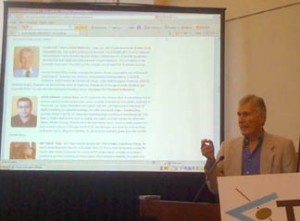 Leading a company, whether a start-up or a global enterprise, can be an all-encompassing experience, and CEOs often “wake up” at intervals and wonder what it’s all for. Cox acknowledged that this point might seem strange to a room full of young Web 2.0 entrepreneurs. He urged people to remain in touch with what was important, even when it causes conflicts with what they are doing businesswise.
Leading a company, whether a start-up or a global enterprise, can be an all-encompassing experience, and CEOs often “wake up” at intervals and wonder what it’s all for. Cox acknowledged that this point might seem strange to a room full of young Web 2.0 entrepreneurs. He urged people to remain in touch with what was important, even when it causes conflicts with what they are doing businesswise.- Most people are periodically arrested by “flashes” of profound insight or conscience when they least expect them, and these are extremely valuable. The problem is, flashes don’t usually fit neatly into what the CEO is doing, and most end up ignoring them or letting them fall off the table. He counsels people to look for them and address them, even if they often seem distracting or even disruptive. Following them may seem like a wasteful distraction, but if you do, you will save time (and money) in the long run. Remember that Cox coaches CEOs, many of whom have lost their enthusiasm and joy in life. He has heard many of them reflect on these flashes of insight that they’d had periodically. Cox, like few others, has heard this over and over.
- To be truly great consistently, a CEO needs to be in touch with what is really unique about him/herself. A seeming paradox: “I’m like all other people. I’m like some other people. I’m like no other person.” All are true.
- Everyone fears failure. Risk-taking is a huge part of living. Do it. He quoted Jacques Martin: “The man of courage flees forward.” Recognize and own fear, but don’t let it control you.
- Cox has done some work with Adlerian psychology, and he referenced “style of life,” which is a (usually) unconscious set of convictions that everyone has. To get to it, answer these three questions: I am —. Life is —. My central goal is —.
- He shared his own experience of having wanted to be invited to “the party.” His solution: throw a big party and invite everyone else, becoming a leader.
- Know what the world needs of you. We are all here to contribute something.
- People who achieve mastery need to make sure their “professional” lives resonate deeply with their sense of purpose, and both must be grounded in their uniqueness. They are usually so good they are unaware of it.
Starting Up: What’s the deal with legal and accounting? Nate Westheimer, Evan Brown, Daliah Saper & Gary Barron
I regret that I was unable to catch the whole session of this very important topic. It’s critical for a start-up CEO to invoke “professional services” at the appropriate time, as legal and finance/accounting structures can have an inordinate effect on the company’s value. In the interest of full disclosure: Daliah Saper has done some legal work for me. Here are a couple of points I gathered in my few minutes at the session:
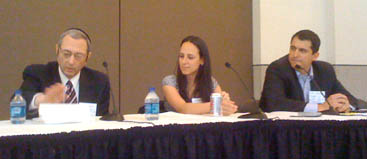 Be very careful when using independent contractors: (?in most states) unless you have a specific “work for hire agreement” in place, independent contractors own the intellectual property of the work they do, even when paid by others (you). Contrast this to when someone is an employee, the company owns the intellectual property employees create.
Be very careful when using independent contractors: (?in most states) unless you have a specific “work for hire agreement” in place, independent contractors own the intellectual property of the work they do, even when paid by others (you). Contrast this to when someone is an employee, the company owns the intellectual property employees create.- Likewise, trademarks are very important. No one likes to incur professional services fees during the cash-poor start-up phase, but if a CEO isn’t careful, s/he can end up investing in a name or concept that someone else can later claim.
- Gary Barron ostensibly discussed tax ramifications of doing Web 2.0 start-ups.
- Evan Brown writes the Internet Cases Blog, which tracks legal developments involving Web 2.0.
- Panelists were asked what professional services costs and how they billed. They encouraged the audience to learn more as such services need not be terribly expensive. The panelists all have significant experience with start-ups and organize themselves accordingly.
Creating A Brand Leveraging New/Social Media For Your Business, Sean Ammirati, Geoff Livingston, Frank Gruber, Danielle Wiley & David Armano
This session emphasized how practical Web 2.0 and social networks/media can be when developing a business. It had only brief remarks from each panelist before launching into an extended Q&A. Highlights:
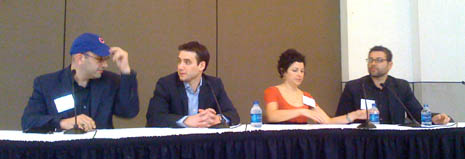 Danielle Wiley, a known blogger who was brought in by PR standardbearer Edelman to ramp up its social media efforts, pointed out that social media was “not just talk,” it was a conversation. Therefore, it was much more engaging for people.
Danielle Wiley, a known blogger who was brought in by PR standardbearer Edelman to ramp up its social media efforts, pointed out that social media was “not just talk,” it was a conversation. Therefore, it was much more engaging for people.- David Armano chimed in that social media represented numerous, diverse perspectives by default (it’s so easy for everyone to add his/her views). Blogging can be a fantastic way to create a brand. Also, you learn by doing because you get instantaneous feedback and responding is fast and easy.
- Geoff Livingston added that social media have “networking” built in since it’s so easy to comment on and share content.
- Frank Gruber pointed out that TechCocktail itself had started as a blog.
- Blogs don’t have to be controversial, although early blogging did tend to have an anti-establishment flavor. That’s only part of it, now that blogging is rapidly becoming mainstream.
- Panelists counseled that authenticity is of utmost importance. Don’t try to fake it because, when people find out, any value that your fakeness had created will be destroyed, plus interest.
- Frank referenced AOL’s jobs blog; they are creating blog properties fairly aggressively. Corporate blogs began as an oxymoron, but companies are gradually figuring it out.
Understanding Your Audience (The Female Perspective), Shawn Bolan, Blagica Bottigliero, Genevieve Thiers & Jen Consalvo
In the U.S., as “Chief Household Officers,” women are the most influential decision makers for an increasing portion of total purchases, so the idea behind this session was to understand “the female perspective.” Of course, one of the main points was that there was no “female perspective” because such a concept pre-supposes that women are a block. However, panelists had numerous insights into engaging women in the conversation:
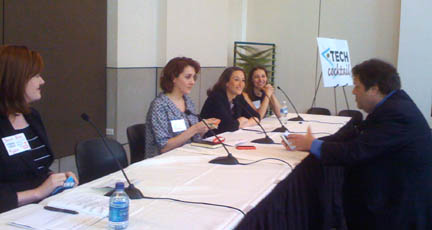 As CHOs, women are usually addressing a greater range of challenges than are men; their attention spans are even shorter. Their free time averages about 60 minutes a day, but this is comprised of ten minute increments.
As CHOs, women are usually addressing a greater range of challenges than are men; their attention spans are even shorter. Their free time averages about 60 minutes a day, but this is comprised of ten minute increments.- Websites need to make it possible to enable buying decisions within ten minutes; they must also communicate very clearly and simply because women have about a dozen things on their minds at once (children, husbands, kids’ sports schedules, contractors of all kinds, meals, inlaws…).
- Women in their 20s and 30s are far more tech savvy than most people give them credit for. However, they are usually not technology enthusiasts like men tend to be; they use technology as a means to an end.
- Women are more focused on friends and are natural connectors. They are less likely than men to make decisions in isolation.
- The social element of Web 2.0 is dead on to how women like to think and make decisions. Therefore, ponder how your company can help women to influence each other. If you make it easy and deliver value, they will go to bat for you. Women are very loyal.
- Most women don’t know RSS, even though they may use it; don’t assume they do.
- SitterCity came up repeatedly during the session; it’s a social network that enables customers to find, engage and comment on babysitters. Babysitters are necessary but women are very demanding because they are trusting their children to a stranger. Together, the site’s members can vet sitters. They are also expanding to pets.
- Women tend to consider the long-term ramifications of decisions more than men do; they are analytical thinkers; they tend to ask why something works or doesn’t.
- Women are often “multisensory”; your site should try to appeal to more than one sense when communicating value.
- I think that most of these principles are good business, for considering female and male customers. Another takeaway: as women are more social in terms of decision-making, social media should serve to increase their total influence because it is in synch with how women like to work.
Ask the Wizard LIVE, Dick Costolo
Dick is the founding CEO of Feedburner, probably the biggest Web 2.0 success story in Chicago thus far. He gave a brief overview of some lessons learned before throwing the floor open for questions:
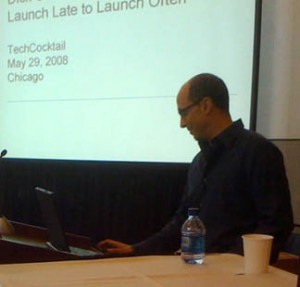 He’s a strong proponent for giving all founders equal stakes; if not, you will find yourselves arguing over shares, ownership structure, etc. every time you want to issue more options. You need to be equally accountable.
He’s a strong proponent for giving all founders equal stakes; if not, you will find yourselves arguing over shares, ownership structure, etc. every time you want to issue more options. You need to be equally accountable.- Entrepreneurs worry too much about valuation. They should be always thinking about two key things: focus and speed of execution (“Google can’t execute fast anymore”). These two things are the start-up’s relative value proposition over established players.
- Dick is not a big supporter of (full) business plans because he observes most are never read, and they take a long time to create. Sizing the market is a bogus concept because its virtually meaningless. You can define any market to be big or small.
- Founders should focus on the team, the product path and market position. Although he didn’t reference it by name, Dick is very focused on the value chain, where your company fits into the ecosystem, and what other players are doing that might increase or decrease your ability to deliver value.
- Location doesn’t matter; you can start up a company anywhere. The (Silicon) Valley’s huge advantage is waning.
- Raise money when you don’t need it. Working with venture capitalists can add significant value; they are experts at helping you think about exit strategies.
- Dick advises to have board meetings every six weeks. He feels that every month is too often, even for a start-up at full bore.
- How you hire employees 1-20 is mission-critical. Do not hire people for specific roles; instead, hire the best available people, and rotate them in roles where you need them. Don’t lock yourself into functions and org charts. You need to focus and execute, and that may mean doing marketing strenuously this quarter and sales more next quarter. You need employees who can flow with your focus and execution.
- Architect for flexibility (remember the value chain focus). If your technology can address the ecosystem, you will increase your chances of winning.
- Don’t get hung up on secrecy. Entrepreneurs tend to think that “someone can steal our idea.” Ideas don’t count unless they’re brought to market, and other people are focused on other things.
- Don’t internationalize until you have to (but architect to enable this later).
- Partnerships, especially with other start-ups, are usually wasteful in the early days; every start-up is focused on itself and has no resources to dedicate to making partnerships work.
- Maintain cash: revenue will always come much more slowly than you think (revenue plans in business plans are a joke).
- Think about “quantum barriers to entry.” Twitter owns microblogging. iTunes owns online music purchasing. Focus on market share.
- Don’t have an exit strategy because it’s a distraction, and exit will come when you focus and execute (remember, you’re doing this better than anyone else, and your claim is based on the big two).
- Entry strategy. Let the business model come to you. Don’t get too hung up on this.
- Distribute your public face, don’t create the cult of the founder. Have other key employees representing your company in public. He contrasted Technorati (founder cult) with Six Apart (distributed).
How to Grow a Community for a Traditional Business, Gary Vaynerchuk, Founder, Wine Library TV
It’s an understatement to say that Gary Vaynerchuk is a Web 2.0 sensation, and his session was funny, insightful and completely intoxicating. Gary began working in “Wine Library,” his parents’ New Jersey wine shop when a child, and he got totally into wine. He eventually ran the retail business but walked away from an operational role to found Wine Library TV in 2006. WLTV is technically a video blog that he produces on location at Wine Library. It features Gary’s unvarnished knowledge, style and attitude toward wine, which is honest, unpretentious and wacky, compared to most other “wine critics” and educators. “Wine doesn’t want to be upper crust, it wants to help people come together around a table.” WLTV has won numerous accolades, and Gary has been featured on numerous mainstream media. From my notes, here are some gems from his treasure chest, which were coming fast and furious and funny:
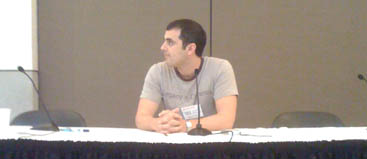 It would have been easy to laugh off this session as a totally entertaining entrée into TechCocktail 8, but in fact Gary’s profound insight into the “Web 2.0 age” made this one of the conference’s most valuable sessions. During times of disruptive transformation, understanding need not be complicated and can be rather simple; the difficulty is knowing what old rules to reject or change. Gary is living testimony to the essence of Web 2.0.
It would have been easy to laugh off this session as a totally entertaining entrée into TechCocktail 8, but in fact Gary’s profound insight into the “Web 2.0 age” made this one of the conference’s most valuable sessions. During times of disruptive transformation, understanding need not be complicated and can be rather simple; the difficulty is knowing what old rules to reject or change. Gary is living testimony to the essence of Web 2.0.- First, technology. Gary predicted that (most people will have access to) live streaming video, often on cell phones, within three years. What it means is that we will all become potential television stations.
- Gary’s message sounds simple but has profound ramifications: be passionate, committed and “work your ass off.” Be true to yourself, be real, be an authority and be transparent. Love what you do. This doesn’t sound like much at first blush, but it is impressive when Gary delivers it because he is passionate.
- Let’s analyze this though. Let’s say that today most people have access to Web 1.0 text and pictures; the barrier to entry to people is virtually zero. Anyone can walk into his/her local library, get on a machine and start blogging. Moreover, most popular art proves that one needn’t even know how to write or sing to be a popular artist. You don’t need grammar (although it helps, it’s not a requirement). Anyone can blog for free. This will soon be true for multimedia, which is a richer experience of you.
- So the barrier is not technology; it’s being noticed. And what do people notice more than anything? Passion. Truth. People want to trust because trust is practical; it’s mankind’s fundamental risk management tool. Authenticity leads to trust. This is in-your-face actionable in the pervasive me-TV age that is dawning.
- When you are authentic, Gary says, you need not have any fear. When you do what you love, you work harder. When you are transparent, there’s no fear because there’s nothing to hide. He has grasped and made actionable a fundamental disruption of Web 2.0: universal transparency.
- Believe in what you do, what product you have, love what you do, and have patience. Gary pointed out how hard he has worked and for how long. He answers hundreds or thousands of emails and other messages. He doesn’t think in terms of numbers; he’ll answer people even if they represent organizations or groups in small towns. “Engage everyone, and ignore numbers. You don’t know who other people know.” He mentioned corresponding with a guy in a remote (part of the Andes) whom most people would have ignored.
- In Web 2.0, according to Gary, we all have the opportunity to develop a personal brand, and we have the tools to communicate it. Of course, that means that the people who understand and act will have the advantage. You could be the rock star of the 1947 Dodgers, for example, or even of a particular player. There are enough people around the world who will appreciate you.
- Building community is key, communicate with everyone (and encourage people to communicate among each other). Embrace chaos; you don’t know how things will turn out, but if you do what you love and work hard, you will succeed. It helps to have talent, too. Gary pointed out that, no matter how passionate he is about the New York Jets, he could never play for the team. But he intends to buy them.
- More analysis: in a networked environment, you no longer direct or push messages to the market in a linear path. There’s no more “marketing funnel.” In a networked environment, you inspire nodes of the network to start firing. Inspiration is noticeable and self-propogating, so it spreads. To inspire is to energize someone else, who then shares his/her excitement with other people. You allow the other person to spread the message.
- When people are being negative (spiteful, mean), address it right away. When you are transparent, others can’t hurt you if you share your side of the story.
- He is asked to advise corporations on blogging and video. The main thing is that you have to be transparent about what you can’t do, but don’t be apologetic or defensive. Tell it straight. Be human. Make fun of yourself.
- The long tail is insane; most people don’t get it. Back to the 1947 Dodgers. In the age of entertainment, niche markets develop, and you can make money and gain notoriety and build your brand by being the most passionate, welcoming and hard-working person about that topic. You will become that node around which people gather. This may take long. He didn’t put it this way, but here’s my rendition of the equation: love + hard work + time = success.
- When you are passionate, things (opportunities) find you; they flow to you.
- For the topper, Gary had a priceless exchange with Ron May, Chicago’s notorious tech gadfly whose style involves haranguing people. To Ron: “You get it, you love what you do, that’s why you are successful. Yes, you like to be the bad guy, but you are extremely happy.” Ron not only did not object, he laughed sheepishly.
- Mobile will create even more niches and opportunities because Web 2.0 + video will be completely mobile and interactive in time and space.
- In sum, be passionate (did you get that? ,^). Love what you do, be transparent, build your personal brand and be honest about what you can and can’t do.
Analysis and Conclusions
- “Plus ça change” is a big part of the theme here for people who cut their teeth during Web 1.0 (I was having flashbacks to Guy Kawasaki and Garage.com’s “Bootcamp for Start-ups”). Start-ups during the Internet boom had the same advantages: speed and execution, as Dick aptly put it. Focusing on the right things, or doing things for the right reasons, is still true (the theme of Allan Cox’s and Mike Domek’s remarks). It’s still important to invoke legal, finance and other professional services probably before you think you need them. Hiring the right people in the early stages is still critical, as is building for extensibility.
- So what’s new and different? The technology is object-oriented, but the distributed paradigm is far more mainstream, and content and functionality reflect that. The session on widgets really brought that point home; widgets are like little engines of functionality and information that are very social; they can appear almost anywhere and invoke content from anywhere. We are still struggling with merging online and offline, but as Adrian’s session showed, the increased standardization of technology is making it easier to share and distribute.
- David Weinberger pointed out that knowledge is social at Big Frontier last year, and that’s the big difference: technology is organizing itself around that reality. In being emergent, technology enables people to share more like how they really think, without imposing process on people. In the past, technology has been too monolithic to accommodate people very well, so people had to accommodate technology. That’s largely over. This point was driven home in the understanding the female audience session, as women will probably be far more involved now that technology imposes less of itself on people.
- As we move into the Knowledge Economy, more people will create value by being stewards of knowledge and inspiring others to share their knowledge. Knowledge is rapidly becoming free. Note, I did not mean “data” or “information”—knowledge will be free. People create and use knowledge to act and create value. During the waning Industrial Economy, knowledge was expensive and precious and hoarded. Now people give it away; the prize is attention and engagement. Gary’s session gave the audience a view into what that might look like: more people will entertain while educating.
- Finally, the Web 2.0 (also think “Gen Y”) culture was very much in evidence, and it is distinctive. Transparency is not really a choice anymore, but people who don’t understand that will pay dearly for it. Being yourself, allowing organization to be emergent and not taking yourself too seriously are big differences.
- The most profound takeaway for me was the link between personal alignment (Gary’s and Allan’s talks), transparency and doing what you love make you more inspiring. In the past, “average people” rarely had the chance to be inspiring because they were just cogs in the (industrial) wheel. But inspiration awakens and prolongs engagement, and it excites network nodes. It can’t be faked in the long term. It’s the key in the Web 2.0 era.
- “Adding value” will increasingly involve people’s personalities. I also perceive that the concept of “work” and “personal” lives will continue to blur and will soon disappear because everyone will know (almost) everything about everyone: to succeed, people will bring more of their personalities to bear on their work, and we already work in bursts all the time and everywhere.
- We will pay to get off the grid.


Chris,
Excellent writeup. I want to resonate with your third-to-last bullet on the “most profound takeaway.” I appreciate that the conference higlighted this trend in web culture, and I appreciate that you highlighted not to “take ourselves too seriously.” I’ve had my fair share of learning experiences in that arena that started very young for me (12+ years ago in early high school, pre web 1.0). Each year that goes by I find myself learning more and more lessons about this. The fact that we are now so interconnected does good to expose people who aren’t transparent and who do take themselves too seriously.
Tim
Chris: this is an interesting series. I have been following your posts more closely since I have shifted to RSS based reading, rather than wade through the pounds of email subscriptions. Anyone else interested in the shift, a good and free RSS reader is http://www.google.com/reader/. Besides the compliment, I wanted to let you know I plan to share your series with someone at a company I believe will be interested. If they are interested in follow-up with or coverage by you, I’ll invite them to contact you, and offer to make the introduction if desired. Also, a friendly typo-correction that caught my eye (since I’m in the IP space): “patientslikeme has [files] –filed– patents for tools…” All the best, Bob
Bob, thanks a lot for your interest, helpfulness and support. I’ve been completely submerged in kicking off a major beta initiative… I apologize for the delays in getting back here. I’m thrilled and grateful for your sharing with other people who are interested in the topic. I will also be sharing an analysis of Social Networking and Healthcare, probably next week.
Tim, thanks for weighing in on that.. it’s a simple thing (everyone has the potential to be inspiring to thousands), but has profound consequences for being and culture. As I reflect on the conference, I say “hats off” to the TC guys for making the first conference so valuable. I feel that they struck the balance between “total Web 2.0” (unconference) and something more structured.